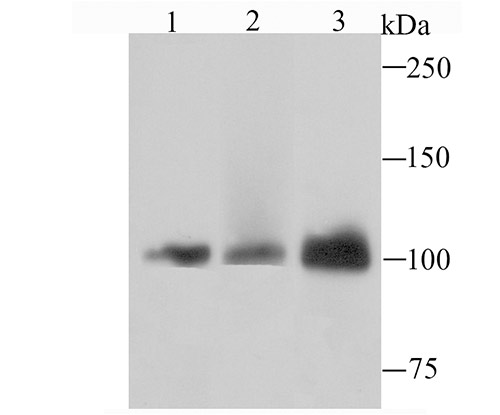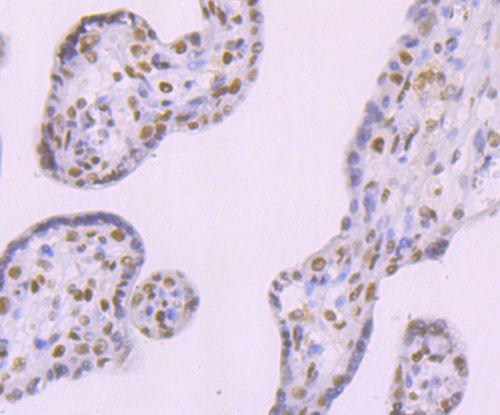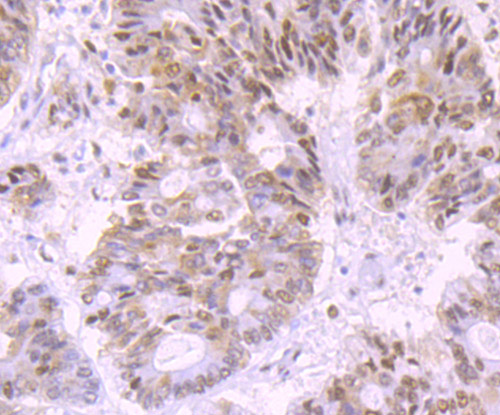
Rabbit Anti-DNA Ligase IV antibody
LIG4; DNA ligase IV ATP dependent; DNA joinase; DNA joinase; DNA ligase 4; DNA ligase IV; DNA repair enzyme; DNA repair enzyme; DNLI4_HUMAN; LIG 4; LIG4; LIG-4; Ligase IV; Ligase IV; Ligase IV DNA ATP dependent; Polydeoxyribonucleotide synthase [ATP] 4; P
View History [Clear]
Details
Product Name DNA Ligase IV Chinese Name DNA连接酶4Recombinant rabbit monoclonal anti Alias LIG4; DNA ligase IV ATP dependent; DNA joinase; DNA joinase; DNA ligase 4; DNA ligase IV; DNA repair enzyme; DNA repair enzyme; DNLI4_HUMAN; LIG 4; LIG4; LIG-4; Ligase IV; Ligase IV; Ligase IV DNA ATP dependent; Polydeoxyribonucleotide synthase [ATP] 4; Polydeoxyribonucleotide synthase 4; Polydeoxyribonucleotide synthase; Polydeoxyribonucleotide synthase; Polynucleotide ligase; Polynucleotide ligase; Sealase. Research Area Cell biology Epigenetics Immunogen Species Rabbit Clonality Monoclonal Clone NO. 2D9 React Species Human, Applications WB=1:500-2000 IHC-P=1:50-200 ICC=1:10-50 (Paraffin sections need antigen repair)
not yet tested in other applications.
optimal dilutions/concentrations should be determined by the end user.Theoretical molecular weight 104kDa Cellular localization The nucleus Form Liquid Concentration 1mg/ml immunogen Recombinant human DNA Ligase IV Lsotype IgG Purification affinity purified by Protein A Buffer Solution 0.01M TBS(pH7.4) with 1% BSA, 0.03% Proclin300 and 50% Glycerol. Storage Shipped at 4℃. Store at -20 °C for one year. Avoid repeated freeze/thaw cycles. Attention This product as supplied is intended for research use only, not for use in human, therapeutic or diagnostic applications. PubMed PubMed Product Detail The X-ray repair cross-complementing protein XRCC4 and DNA Ligase IV are essential for repairing double-strand breaks in DNA. These proteins form a critical complex consisting of two molecules of each protein that preferentially bind DNA with nicks or broken ends. As an obligate accessory molecule, XRCC4 binds to DNA Ligase IV and enhances its joining activity. The XRCC4/ DNA Ligase IV complex is also involved in V(D)J recombination. V(D)J recombination occurs in normal development of the adaptive immune system and involves the formation of a double-strand break intermediate. Deletions of either DNA Ligase IV or XRCC4 inhibit the completion of V(D)J recombination, resulting in a high incidence of apoptosis in the developing nervous system and a block in B and T cell maturation.
Function:
Efficiently joins single-strand breaks in a double-stranded polydeoxynucleotide in an ATP-dependent reaction. Involved in DNA non-homologous end joining (NHEJ) required for double-strand break repair and V(D)J recombination. The LIG4-XRCC4 complex is responsible for the NHEJ ligation step, and XRCC4 enhances the joining activity of LIG4. Binding of the LIG4-XRCC4 complex to DNA ends is dependent on the assembly of the DNA-dependent protein kinase complex DNA-PK to these DNA ends.
Subcellular Location:
Testis, thymus, prostate and heart.
DISEASE:
Defects in LIG4 are the cause of LIG4 syndrome (LIG4S) [MIM:606593]. This disease is characterized by immunodeficiency and developmental and growth delay. Patients display unusual facial features, microcephaly, growth and/or developmental delay, pancytopenia, and various skin abnormalities.
Defects in LIG4 are a cause of severe combined immunodeficiency autosomal recessive T-cell-negative/B-cell-negative/NK-cell-positive with sensitivity to ionizing radiation (RSSCID) [MIM:602450]. SCID refers to a genetically and clinically heterogeneous group of rare congenital disorders characterized by impairment of both humoral and cell-mediated immunity, leukopenia, and low or absent antibody levels. Patients with SCID present in infancy with recurrent, persistent infections by opportunistic organisms. The common characteristic of all types of SCID is absence of T-cell-mediated cellular immunity due to a defect in T-cell development. Individuals affected by RS-SCID show defects in the DNA repair machinery necessary for coding joint formation and the completion of V(D)J recombination. A subset of cells from such patients show increased radiosensitivity.
Similarity:
Belongs to the ATP-dependent DNA ligase family.
Contains 2 BRCT domains.
SWISS:
P49917
Gene ID:
3981
Database links:Entrez Gene: 3981 Human
Entrez Gene: 319583 Mouse
Entrez Gene: 100173511 Orangutan
Omim: 601837 Human
SwissProt: P49917 Human
SwissProt: Q8BTF7 Mouse
SwissProt: Q5R6L3 Orangutan
Unigene: 166091 Human
Unigene: 80584 Mouse
Product Picture
Lane 1: HepG2 cell lysate
Lane 2: Hela cell lysate
Lane 3: Jurkat cell lysate
Primary: Anti-DNA Ligase IV (SLM-54131R) at 1:1000 dilution
Secondary: Goat Anti-Rabbit IgG - HRP at 1:5000 dilution
Predicted band size: 104 kD
Observed band size: 104 kD
Paraformaldehyde-fixed, paraffin embedded (human placenta tissue); Antigen retrieval by boiling in sodium citrate buffer (pH6.0) for 15min; Block endogenous peroxidase by 3% hydrogen peroxide for 20 minutes; Blocking buffer (normal goat serum) at 37°C for 30min; Antibody incubation with (DNA Ligase IV) Monoclonal Antibody, Unconjugated (SLM-54131R) at 1:50 overnight at 4°C, followed by operating according to SP Kit(Rabbit) (sp-0023) instructionsand DAB staining.Paraformaldehyde-fixed, paraffin embedded (human colon cancer); Antigen retrieval by boiling in sodium citrate buffer (pH6.0) for 15min; Block endogenous peroxidase by 3% hydrogen peroxide for 20 minutes; Blocking buffer (normal goat serum) at 37°C for 30min; Antibody incubation with (DNA Ligase IV) Monoclonal Antibody, Unconjugated (SLM-54131R) at 1:50 overnight at 4°C, followed by operating according to SP Kit(Rabbit) (sp-0023) instructionsand DAB staining.
References (0)
No References
Bought notes(bought amounts latest0)
No one bought this product
User Comment(Total0User Comment Num)
- No comment





 +86 571 56623320
+86 571 56623320
 +86 18668110335
+86 18668110335

